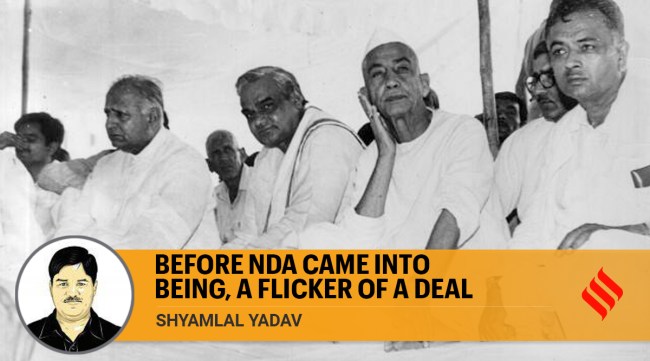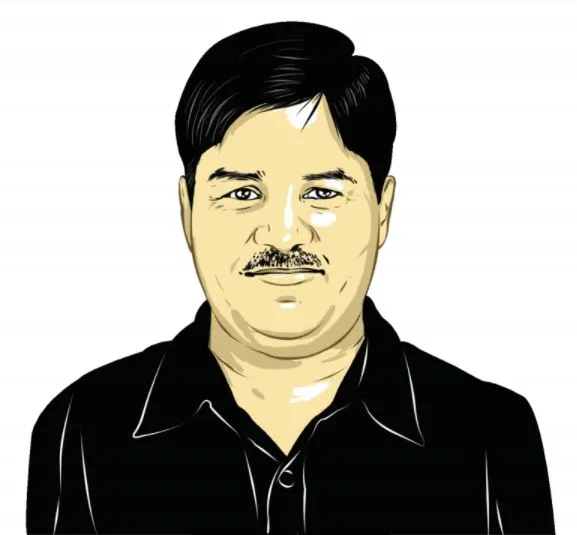Opinion Story of the other NDA, which survived only over a year during 1983-84
While it's right that the NDA in its current form has completed 25 years, the first avatar of the alliance came about much earlier — in August 1983 — but it did not work and collapsed just a year later.
 Charan Singh (right) with Vajpayee. Their alliance lasted a year. (Express Archive)
Charan Singh (right) with Vajpayee. Their alliance lasted a year. (Express Archive) May 15 was the 25th anniversary of the National Democratic Alliance (NDA) that was formed in 1998. On May 26, Prime Minister Narendra Modi reminded his party that no alliance other than the NDA has remained intact for a quarter century. And he was correct.
While it’s right that the NDA in its current form has completed 25 years, the first avatar of the alliance came about much earlier — in August 1983 — but it did not work and collapsed just a year later.
Those days, much like it is today, the ruling party at the Centre was in formidable form and the Opposition was struggling to find its feet. The Congress had returned to power in 1980 and later, the Indira Gandhi government had sacked some non-Congress state governments. The Janata Party, which had come to power in 1977 as an amalgamation of parties with different ideologies, was splintering into groups. In April 1980, those who joined the Janata Party from the Bharatiya Jana Sangh (BJS) decided to form a new party, which they named the Bharatiya Janata Party (BJP).
Efforts to form alliances against the central government gathered pace – not very different from the situation now, when 15 non-BJP leaders met in Patna to come up with a strategy ahead of the 2024 polls.
After the Indira government had completed nearly half its tenure, these efforts were hastened. In the meantime, some states saw fresh Assembly polls and important changes happened in Karnataka and Andhra Pradesh. In Jammu and Kashmir, Farooq Abdullah took over as Chief Minister on September 8, 1982, the day his father Sheikh Abdullah passed away. While his government continued in 1983 Assembly polls, in Karnataka, a new government under the Janata Party was formed with Ramakrishna Hegde as CM on January 10, 1983. In Andhra Pradesh, Telugu film star-turned-politician NT Rama Rao of the Telugu Desam Party (TDP) took oath as Chief Minister on January 9, 1983. In the coming years, these three Chief Ministers would play key roles in Opposition unity efforts.
The churn of those years saw the emergence of leaders and the decline of others. Chaudhary Charan Singh, who had split the Janata Party to form the Janata Party (Secular) to take oath as Prime Minister in 1979, later renamed his party Lok Dal. The Lok Dal was further divided into Lok Dal (Charan Singh) and Lok Dal (Karpuri Thakur). Several in the Opposition were one-man parties or rode on the popularity of a single leader: Congress (Jagjivan) of Jagjivan Ram, the Democratic Socialist Party (DSP) of H N Bahuguna, the Janwadi Party of Chandrajit Yadav and Lok Dal (K), which had leaders like George Fernandes, Madhu Limaye, Devi Lal and Biju Patnaik.
Efforts were on to form a single party merging the Janata Party, the DSP and the Janwadi Party, but Morarji Desai had some reservations against the move. Chandra Shekhar headed the Janata Party and in August 1983, intense talks were on for a possible alliance among “progressive and socialist” national and regional parties or over the merger of some of them. The United Front (UF) was formed later, towards the end of 1983, with the Janata Party being a big player in the alliance.
At the same time, there were efforts for the merger of two big players of the Opposition — the Lok Dal (C) and the BJP. Talks were on between BJP chief Atal Bihari Vajpayee and Charan Singh. Still scarred from its experience in the Janata Party, the BJP kept declining Charan Singh’s proposal. In a meeting of its national executive in Bhubaneswar on February 12-14, 1982, the BJP said it was against a merger with any other party, but clarified that it would follow the policy of “meaningful cooperation”.
While Charan Singh kept demanding a merger, Vajpayee clarified in Shimla in April 1983 that he and his party were against any sort of merger. However, the BJP kept raising the need for a national democratic front against the ruling Congress (I) and meetings between leaders of the BJP and Lok Dal (C) started afresh. In mid-August 1983, the NDA was formed with these two players. As per the agreement, Charan Singh became the leader of the NDA in the Lok Sabha and L K Advani in the Rajya Sabha. And that is how the NDA was first born.
With the formation of the NDA, with its two parties, and the UF, with its nine parties, efforts were on to form an understanding between both alliances in order to fight against the Congress (I).
In October 1983, J&K Chief Minister Farooq Abdullah hosted a meeting of Opposition leaders in Srinagar. After the meeting, a resolution on Centre-state ties was adopted. The meeting was attended by Opposition stalwarts Parkash Singh Badal, Chandrajit Yadav, Biju Patnaik, Jagjivan Ram and N T Rama Rao. Despite being invited, Charan Singh and Vajpayee did not attend the meeting. Later, they claimed that they received the invite quite late.
But the NDA, formed with an eye on the elections, did not survive long. In August 1984, merely a year after it was formed, both parties started making conflicting statements. Vajpayee and Charan Singh would often say that they were unsure about the future of the NDA. While the BJP decided to go it alone, Charan Singh formed a new party, the Dalit Mazdoor Kisan Party (DMKP).
The assassination of Indira Gandhi in October 1984 changed the political scene. Riding on a wave of sympathy, the Congress swept to power.






